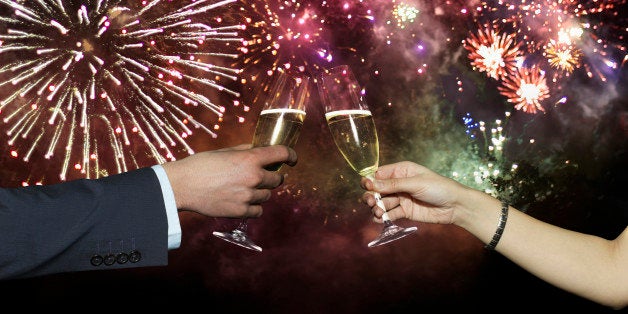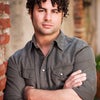
Fun Fact: Many of us will start out the New Year babbling incoherently at the top of our lungs.
"Should old acquaintance be forgot and something blah blah blah!!!"
Auld Lang Syne. That mournful, ecstatic, glassy-eyed dirge that greets every New Year with equal parts melancholy and excitement.
Sometimes New Year's Eve can be a huge letdown. It's just one night. But we've built it into something which simply must be sensational. If all our party-planning, playlisting and coordinating don't go exactly right, midnight can creep up pretty fast, maybe even before we're ready. But wherever you are when this tune hits, it really does wash over you with incredible power, particularly for a composition well over 200 years in age.
At 11:59 PM, couples are coupled, revelers are counting down, and everybody is bracing for the familiar strains of that otherwise difficult-to-understand song. Whatever the year before was like, whatever disappointment, sadness, joy, anticipation, regret or gratitude filled the 12 months behind you, it all gets balled up into the emotional jumble of trumpets, clarinets and butchered Scottish verse that is Auld Lang Syne.
Even if you haven't a clue what it means, Auld Lang Syne evokes an undeniable sentimentality, a disorienting nostalgia, an instantaneous affection for the people around you at that exact moment; loved ones and strangers alike. A New Year stands before you, brimming with possibility. Whatever the hell that song is about, it makes you well up with a distinctly wintery kind of warmth.
Scottish poet Robert Burns drafted the song in 1788 after hearing it warbled by an old man. He too was moved by its beauty and longing. Even at this stage in its evolution, Auld Lang Syne was well-aged through oral tradition and literary reference. However, the Burns composition helped to make it enormously popular, as did increasingly regular performance of the song on the occasion of New Year's Eve.
As to why it remains ceaselessly relevant today, we look to its meaning. Taken from the original Scottish, Auld Lang Syne translates to something like 'For Long Ago', though there are many variations on the exact phrasing.
But what about the rest of it?
Well, when 12:00 AM arrives, we start the year off not with a statement of affirmation, but with a question:
Should old acquaintance be forgot,
And never brought to mind?
Should old acquaintance be forgot,
And long, long ago.
As we squint bravely at the bright face of a new year, the song asks, how shall we treat our memory of dear friends, distant or departed.
Simply stated, Auld Lang Syne is about the endurance of friendship, about cherishing the past even as we look to the future, and quite honestly, about knocking back a few drinks:
And for long, long ago, my dear
For long, long ago,
We'll take a cup of kindness yet,
For long, long ago
And surely you'll buy your pint-jug!
And surely I'll buy mine!
And we'll take a cup of kindness yet,
For long, long ago.
We're verging on 12:01 AM at this point, the sloppiest, most emotionally unashamed moment of the night, perhaps even of the calendar year. You are perfectly vulnerable, greased up for the swelling New Orleans-funeral-styled crescendo of Auld Lang Syne. You can be forgiven for a little eyeball leakage.
Indeed, so powerful is the emotional provocation of the song that it was actually banned from performance on the Civil War battlefront in December of 1862. The Union Army had just suffered a crushing defeat at the Battle of Fredericksburg. With morale extremely low, Union generals worried that homesick soldiers would be moved to desertion by the song's aching sentimentality.
That remarkable power may well be the reason that it achieved a new kind of cultural permanency in the 20th Century. If you've ever spent any time browsing the dollar bins at your local record store, you've seen the name Guy Lombardo and His Royal Canadians. That's right. Justin Bieber isn't the first heartthrob from north of the border.
Trumpeter Guy Lombardo and his three brothers formed the nucleus of the Royal Canadians, the party band contracted to play the Roosevelt Hotel's New Year's Eve bash in 1929. As fortune had it, the upscale Manhattan hotel wanted everybody to know that they were having an awesome party, so they broadcast it on NBC Radio.
In spite of selling well over 100 million records in the U.S. alone, Lombardo is widely forgotten in the world outside of my grandmother's apartment. But his decision to dust off an old chestnut on that midnight would have historical ramifications, forever tying this song to every sloppy kiss, every glass-clinking toast, every euphoric hug shared between strangers, every well-intended-but-forgotten-by-February resolution that marks 12:01, January 1st.
The Roosevelt had a hit on its hands. Lombardo ascended to the title of Mr. New Year's Eve over the course of a three-decade engagement with the hotel. The relationship between song and holiday became inextricable. In the late '50s, Lombardo took his show to the Waldorf-Astoria and CBS Television, virtually defining the role of modern New Year's Eve emcee, complete with gentle one-liners, semi-climactic ball drop and Times Square pandemonium. Lombardo held this post and ratings supremacy until his death in 1977.
With Lombardo's passing, the fledgling Dick Clark's New Year's Rockin' Eve (newly minted in 1974) ascended to singular dominance. In addition to unseating the Royal Canadians, Dick Clark would eventually co-opt their recording as well. This remains the version of Auld Lang Syne you are likeliest to hear on New Year's Eve.
But back to what the song actually means:
We two have run about the hills
And pulled the daisies fine;
But we've wandered many the weary foot
Since long, long ago.
We two have paddled in the stream,
From morning sun till dine;
But seas between us broad have roared
Since long, long ago.
New Year's Eve is a time of reflection, albeit reflection drowned out by loud music and slurred conversation. As you anticipate, plan and hope for the coming year, you can't help but think of the years behind you, not just the one immediately passed but all that came before it, that made you who you are at this moment. Auld Lang Syne reminds us of all the people who filled those formative years.
Quite to the point, it's usually at about this time, maybe 12:02 AM, that you've sent a mass text to everybody you know with loving sentiments and perhaps a sweaty selfie from an unflattering angle. This is the digital equivalent of raising a collective glass as per the song's insistence:
And there's a hand, my trusty friend!
And give us a hand of yours!
And we'll take a deep draught of good-will
For long, long ago.
That is to say, let's drink to one another, to our past, our present and our future.
This is the first song that we hear every single year. That's a huge responsibility. Even if it's just another date on the calendar to you, even if you don't really get hung up on the whole clean slate thing, even if you're kind of a bummer to those of us who like to make a big deal out of things, it's hard not to get swept up in the momentum of this song. It tells you everything you really need to know for the coming year: Stay close to the people who matter.
This is why even 100 years from now, when a robotic Ryan Seacrest broadcasts Dick Clark's New Year's Rockin' Eve from whatever international space station we've created simply for containment of the robotic Ryan Seacrest, we'll still be sloppy-kissing, stranger-hugging, glass-clinking and resolution-breaking to Auld Lang Syne.
Happy New Year! May 2014 bring you the very best!
